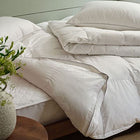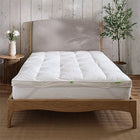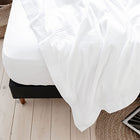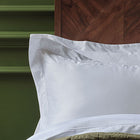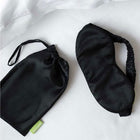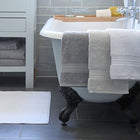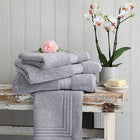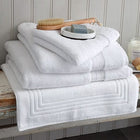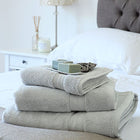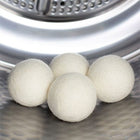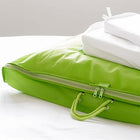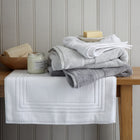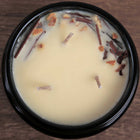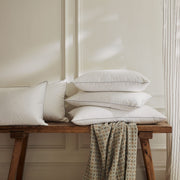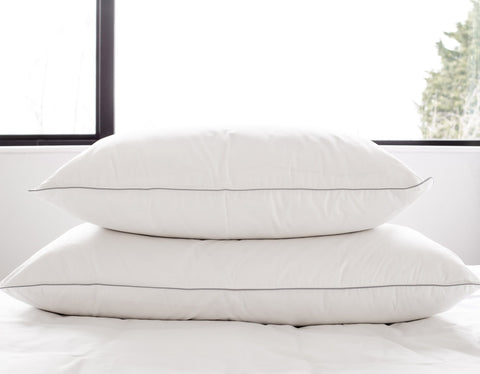
How to choose a pillow?
Choose the best pillow by considering the pillow filling, the support the pillow offers, size and accreditations, along with your favoured sleeping position. This will help you decide what the best pillow is for you to sleep on.
The perfect pillow should feel luxurious, combining the best filling with the best support for your sleep position. It should ideally be breathable, long-lasting and spring back after use. It shouldn’t set off your allergies, go flat or lose its shape after six months.
How to choose a pillow:
- What are the different pillow fillings?
- What is the best pillow for all sleep positions?
- What is the best pillow for allergy sufferers?
- Speciality pillow options
- What is a chamber pillow?
- Ethical & eco-friendly pillows
- What are the standard pillow sizes in the UK?
- How often should I replace my pillow?
What are the different pillow fillings?
Your first choice is whether to go natural or synthetic. A natural pillow filling will offer greater breathability and be better for your health. Either filling option can be allergen resistant if it’s good quality and properly cared for. Check the packaging or care label for the dust-mite anti-allergy NOMITE mark.
Natural pillow fillings:
Down pillow filling: 100% down pillow fillings produce a very soft and fluffy pillow filling that plumps back up well after being squashed. Goose down clusters are larger than duck down clusters providing greater loft and fluffiness. As 100% down pillows don't give a lot of support, the down is often combined with feather to create the right balance of support and comfort.
For the Scooms Hungarian goose down pillow, we chose a special blend of goose down and feather provide the ideal firmness, softness and support.
Feather pillow filling: 100% feather pillow fillings are much firmer than down pillow fillings. Whilst retaining a luxurious, squashy feel, feathers lack the loft of down and provide a flatter sleeping experience. They are a cheaper option than down pillows.
Wool pillow filling: A great eco-friendly option. Wool pillows are often customisable as they are made up of small, fluffy balls of wool that can be teased into shape. A wool pillow should provide good support and give, but will not have the puffy, lofty feel of a down and feather pillow.
Tencel, silk & cotton pillow fillings: These other natural choices are hypoallergenic and breathable. They provide a firmer pillow feel as they are more naturally compressed and have less loft than a down pillow.
Synthetic pillow fillings:
Man-made fibres can be manufactured to different measurements of thickness.
Hollowfibre pillow filling: A hollow thick synthetic fibre which is lightweight but firm. Creates a supportive pillow if well filled.
Microfibre pillow filling: A much finer synthetic fibre which is soft and silky and produces a pillow with medium firmness. If well packed, they can provide good neck support.
Memory foam pillow filling: Developed by NASA scientists! It contours to the shape of your head and only adjusts shape slightly, providing good support if you can get used to it. Not washable though and they can retain heat.
What is the best pillow for all sleep positions?
A great pillow is key to a good night’s sleep. Your pillow should support the alignment of your neck, head and spine as you sleep. Ideally you should sleep on your side or your back for a comfortable night’s sleep rather than on your stomach as this can put stress on your spine.
You should only need to sleep with one pillow. If you find you need more support then it’s time to find the right pillow.
The best pillow for side sleepers: Your pillow should be higher under your neck than your head to keep your spine straight when you sleep on your side. Choose a firm pillow or if that doesn't suit you, a pillow with a firmer core and softer outer layer for a more comfortable option.
The best pillow for back sleepers: Back sleepers need less support, but just enough support to keep the upper spine in alignment. A softer pillow that still provides some support is ideal.
The best pillow for front sleepers: Look for a soft, thin pillow that will help to keep your head flat and won't intensify the slight twist of your spine as you lie on your front.
The best pillow for combination sleepers: If you find yourself swapping sleep positions during the night, then opt for a medium height, medium firm pillow that offers support when you sleep on your side but doesn't throw your neck out of alignment when you roll over onto your back.
What is the best pillow for allergy sufferers?
The majority of people with pillow allergies are allergic to the dust mites that like to live in your pillow. Symptoms include sneezing, itchy nose, watery eyes, sore throat, skin rash and other breathing problems. If you experience any of these symptoms, then make sure the pillow you choose comes with an anti-allergy accreditation such as Nomite. Scooms pillows come with a dust mite proof pillow casing, approved by Nomite.
If a pillow is labelled 'hypoallergenic', this means that the pillow materials and filling are not made of a potential allergen. Be aware that these pillows are not 'anti-allergy' and can unfortunately still be attractive places to live for dust-mites! If you know you have an allergy to wool, latex or feathers, then make sure you buy a hypoallergenic pillow and ideally one also marked 'anti-allergy' so that is is dust-mite resistant.
Speciality pillow options
There are different speciality pillow options if you do suffer from particular sleep issues:
Orthopaedic pillows: Generally, a firm pillow made in a specific shape and size to support your neck, shoulders or spine if you find you are experiencing an aching neck or head.
See our guide to Best pillow for neck pain.
Anti-snore pillows: Designed to help you breathe better with the aim to stop you snoring. There is little proof that these pillows, which come in many designs and sizes, are effective.
Cooling pillows: Created to keep your face cool as you sleep. Can be helpful if you typically experience night sweats or hot flushes. These cooling pillows are filled with small beads that are supposed to absorb and whisk away heat.
Water pillows: You can create your own levels of support and density with a water filled pillow. Water pillows are often recommended by chiropractors and physical therapists.
What is a chamber pillow?
How a pillow is constructed can have a big impact on the support it provides. A chamber pillow is essentially a sandwich with a central core of firm filling such as feather and outer surrounding chambers of soft, squidgy filling like goose down, as in the Scooms pillow. This provides good support for the head and neck.
Synthetic pillows can also use chamber construction and may have firmer hollowfibre in the core for support with softer microfibre in the surrounding chambers.
Ethical & eco-friendly pillows
Make sure the pillow you buy comes with the right environmental and ethical accreditations.
Invest in the best quality pillow you can afford as it will be more durable than a cheap pillow and you won't need to replace your pillow so often. A good night's sleep is essential for a healthy and productive life, so don't buy cheap synthetic pillows that will not only give you a bad night's sleep but will also regularly end up in landfill. Natural fillings are biodegradable unlike synthetic fillings. Check out newer brands producing eco-friendly wool and plant fibre pillows. Be aware that synthetic materials like microfibre and memory foam are not biodegradeable and may leak microplastics into the environment.
If you choose a down or feather filled pillow, check that the filling has been ethically sourced and is independantly accredited by the Responsible Down Standard or DownPass.
Ensure that no toxins or chemicals have been used in the pillow manufacture by looking for the Oeko-tex 100 Standard.
The packaging your pillow comes in is often single use plastic that is not recyclable. Try to buy from pillow brands that only use reusable and recyclable packaging. We dispatch our pillows in fully recyclable Forest Stewardship Council (FSC) certified cardboard boxes with recyclable paper packing tape.
What are the standard pillow sizes in the uk?
There is no specific reason to choose a particular sized pillow apart from your bed size and your personal comfort. Go for a standard pillow size, 50cm x 75cm (20” x 30”), if you have a single bed, double bed or king size bed.
If you have a super king size bed or an emperor bed, then a larger king size pillow 50cm x 90cm (20” x 35”) will fit best. (This size can also be called super king.)
See our guide to pillow sizes.
How often should I replace my pillow?
Many sleep experts recommend replacing a pillow every one to two years. Pillows lose their ability to be supportive over time. Different fillings do have different durability; natural down and feather pillows last longer than polyester filled pillows for example.
Pillows absorb body oils, dead skin cells and can attract dust mites, so regular washing, such as every six months, can extend your pillow's lifespan. Check the care label on your pillow for washing instructions. Foam pillows can’t be washed however.
Make sure you wash your pillowcase regularly, either once a week or more often if you notice that your pillowcase looks a bit grubby after 3 or 4 days.
If recommended by the pillow manufacturer, you can also invest in a pillow protector which provides an extra barrier between the pillow and the pillowcase. A pillow protector can also be regularly washed to help to keep your pillow cleaner for longer.
See our guide on How to clean your pillow.
And once you have chosen your pillow you might want to think of a new pillowcase to go with it. See our guide on the difference between Oxford and housewife pillowcases.
Pillow Buying FAQs:
What do I need to consider when choosing a pillow?There are 4 key criteria to consider when choosing a new pillow. The filling, level of support for your sleep position, size and any necessary accreditations. Look for the Responsible Down Standard and DownPass for down and feather pillows, Nomite if you are allergic to dust-mites and Oeko-Tex to ensure no toxins have been used in the pillow production. What are the types of pillow filling?Down and feather - usually combined in varying amounts to create the right support and comfort. Down is fine, soft and springy. Feathers add weight, firmness and support. Wool, tencel, silk and cotton - generally firmer as they are more naturally compressed. Hollowfibre - a hollow thick synthetic fibre which is lightweight but firm. Microfibre - a much finer synthetic fibre which is soft and silky. Memory foam – which contours to the shape of your head. What are the standard pillow sizes in the UK?There are 2 main pillows sizes in the UK: standard pillows, 50cm x 75cm (20” x 30”) and king size pillows which are 50cm x 90cm (20” x 35”). How often should I replace my pillows?Many sleep experts recommend replacing a pillow every one to two years. What pillowcases should I pair my pillow with?We always recommend pairing with a natural fabric. Such as Egyptian cotton, linen or silk.
|
